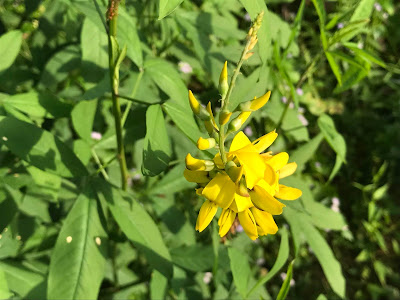太阳麻可供药用,常作为解毒及麻醉的有效药。茎枝可做各种绳索,麻袋等。其纤维可做造纸的原料。因含有丰富的氮、磷、钾,又可作绿肥,有改良土壤之效。
太阳麻可供药用,含有毛束草碱、千里光碱、千里光叶碱、瑞德灵碱。
太阳麻
原 產 地 印度
【性味归经】:苦,寒。肝、膀胱二经。
叶子的初步植物化学筛选产生碳水化合物,类固醇,三萜,酚类,类黄酮,生物碱,氨基酸,皂苷,糖苷,单宁和挥发油。
1. 根:
利尿解毒。主治尿浊,小便淋痛,尿道结石,疥癣,跌打损伤。
2. 种子
治牙痛、外敷大恶疮,疥癣。
【功 效】:利尿通淋、清热解毒、止痛。
【主 治】:治浊淋、尿频、尿急、尿痛、石淋、癣疥、跌打损伤、尿结石、膀胱炎、
[用法用量]
内服:煎汤,3~10g。外用:适量,捣敷;或煎水洗。
山苦瓜的功效. momordica charantia benefits .Peria katak.
印度神花~狗牙花/马茶花. Crape Jasmine uses。manfaat mondokaki。
黃花酢醬草的功效与作用.Oxalis corniculata uses.Manfaat Tanaman Semanggi。https://www.youtube.com/watch?v=N5CVaVv88DY
火炭母的功效与作用。polygonum chinense medicinal uses。 Manfaat sembuluh。
(生姜)神奇秘方,治水咳,脾胃不好.一步一步做给你看。DIY. Treat flu ,Cold cough. The Making of Ginger Juice.
白鹤灵芝草的功效。Rhinacanthus nasutus ~(Snake jasmine )medicinal uses。
https://www.youtube.com/watch?v=K654XhQHATg
Crotalaria juncea, known as brown hemp, Indian hemp, Madras hemp, or sunn hemp, is a tropical Asian plant of the legume family (Fabaceae). It is generally considered to have originated in India.
It is now widely grown throughout the tropics and subtropics[2] as a source of green manure, fodder and lignified fiber obtained from its stem. Sunn hemp is also being looked at as a possible bio-fuel.[4] It can be an Invasive weed and has been listed as a noxious weed in some jurisdictions.
Leaves containing an abundance of mucilage, a little solid fat and a resin soluble in ether. - Phytochemical screening of ethanol extract of flowers and seeds yielded steroids, triterpenes, flavonoids, phenolics and glycosides. - Preliminary phytochemical screening of leaves yielded carbohydrates, steroids, Triterpenes, phenolics, flavonoids, alkaloids, amino acids, saponins, glycosides, tannins, and volatile oils.
-The seeds are considered to be anti-inflammatory, anti-ulcerogenic, antilipulic, antifungal , antioxidant properties.
Poison: Seeds are reported to be poisonous to livestock; however, seeds are reportedly fed to horses in the Soviet Union and to pigs in Rhodesia. The seeds of many Crotalaria species contain toxic pyrrolizidine alkaloids. Trichodesmine is the principal toxic alkaloid in C. juncea C. juncea should not be fed to horses, and intake of hay by cattle should be restricted to 10% of their diet
Fiber: Cultivated for the strong bast fiber extracted from the bark, more durable than jute. Used to make twine, rug yarn, cigarette and tissue papers, fish nets, cordage, etc. (11) It is not as strong as hemp (Cannabis "Sandiva" Forage: Used as forage in Sri Lanka and southern Africa. Leaves and stems are dried, as animals do not eat them green. While drying the forage avoids adverse effects, animals still suffer toxic effects when fed large amounts of seed.
Anti-Inflammatory / Anti-Ulcerogenic: Study showed CJ extract significantly inhibited adjuvant induced arthritis in rats. It also possessed anti-ulcerogenic property which may be due to an appetite suppressant effect.
• Toxicological Studies on Seeds: Study showed the administration of a dose of 200 mg/kg of extracts of seeds on liver, kidney, spleen and adrenals of adult rats caused significant alterations. Organ net weight decreased, histology showed disintegration necrosis and degeneration in the liver, renal tubular cell degeneration and exfoliation, zona glomerulosa hypertrophy in the adrenals, and splenic increase in megakaryotic cells and lymphocytes
Leaves containing an abundance of mucilage, a little solid fat and a resin soluble in ether. - Phytochemical screening of ethanol extract of flowers and seeds yielded steroids, triterpenes, flavonoids, phenolics and glycosides. - Preliminary phytochemical screening of leaves yielded carbohydrates, steroids, Triterpenes, phenolics, flavonoids, alkaloids, amino acids, saponins, glycosides, tannins, and volatile oils.
-The seeds are considered to be anti-inflammatory, anti-ulcerogenic, antilipulic, antifungal , antioxidant properties.
Poison: Seeds are reported to be poisonous to livestock; however, seeds are reportedly fed to horses in the Soviet Union and to pigs in Rhodesia. The seeds of many Crotalaria species contain toxic pyrrolizidine alkaloids. Trichodesmine is the principal toxic alkaloid in C. juncea C. juncea should not be fed to horses, and intake of hay by cattle should be restricted to 10% of their diet
















没有评论:
发表评论